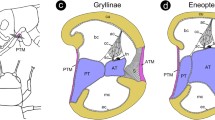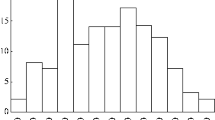Abstract
From behavioural experiments it is known that the thresholds for both positive and the negative phonotaxis in crickets (Gryllus bimaculatus) decrease during the first days of adult life. Neuronal recordings have shown that a part of the changes in threshold has its origin in the ears. In this study we investigate some changes of the mechanics of the ears in the days after the imaginal moult.
The posterior tympanum starts to work as an acoustic window only after the imaginal moult. During the first days the vibration amplitude tends to increase, except below 4 kHz and between 6 and 12 kHz. In the mature hearing organ, the tympanal vibrations exceed those of the surrounding cuticle up to ca. 50 kHz, and peaks of vibration amplitude are found around 5 and 15 kHz (the frequencies of the calling and courtship songs). The appearance of these peaks is caused, at least in part, by a change in the mechanics of the tympanum.
Sound propagation through the trachea connecting the ipsilateral acoustic spiracle and the inner surface of the tympanum does not change much during the first week of adult life. In contrast, the propagation from the contralateral spiracle improves considerably. Thus the tympanum of the newly moulted cricket receives only little sound from the contralateral spiracle, and therefore the ear lacks the sound component which is essential for directional hearing in the mature cricket.
Similar content being viewed by others
References
Ander K (1939) Vergleichend-anatomische und phylogenetische Studien über die Ensifera. Opusc Entomol Suppl 2: 1–306
Armitage P, Berry G (1987) Statistical methods in medical research. 2. ed. Blackwell, Oxford
Atkins G, Henley J, Handysides R, Stout J (1992) Evaluation of the behavioral roles of ascending auditory interneurons in calling song phonotaxis by the female cricket (Acheta domesticus). J Comp Physiol A 170: 363–372
Ball E, Cowan A (1978) Ultrastructural study of the development of the auditory tympana in the cricket Teleogryllus commodus (Walker). J Embryol Exp Morphol 46: 75–87
Ball E, Hill K (1978) Functional development of the auditory system of the cricket Teleogryllus commodus. J Comp Physiol 127: 131–138
Ball E, Young D (1974) Structure and development of the auditory system in the prothoracic leg of the cricket Teleogryllus commodus (Walker). II. Postembryonic development. Z Zellforsch 147: 313–324
Ball E, Oldfield B, Michel K (1989) Auditory organ structure, development and function. In: Huber F, Moore T, Loher W (eds) Cricket behavior and neurobiology. Cornell Univ Press, Ithaca, pp 391–422
Batschelet E (1981) Circular statistics in biology. Academic Press, London
Esch H, Huber F, Wohlers D (1980) Primary auditory neurons in crickets: physiology and central projections. J Comp Physiol 137: 27–38
Faucheux M-J (1972) Origine, ultrastructure et fonctions de la membrane tapissant le fond des vésicules acoustiques dans les genres Acheta et Gryllus (Orthoptères Gryllides). CR Acad Sc Paris 274: 3405–3408
Huber F (1982) Der Weg vom Verhalten zur einzelnen Nervenzelle (Studien an Grillen). Akad Wiss Lit Abh Math Naturwiss Kl (Mainz) 3: 1–40
Huber F (1987) Neuroethologie: Vom Verhalten zur einzelnen Nervenzelle. Konstanzener Universitätsreden 162, 46 p.
Hutchings M, Lewis B (1981) Response properties of primary auditory fibers in the cricket Teleogryllus oceanicus (Le Guillou). J Comp Physiol 143: 129–134
Johnstone B, Saunders J, Johnstone J (1970) Tympanic membrane response in the cricket. Nature (London) 227: 625–626
Larsen ON, Michelsen A (1978) Biophysics of the ensiferan ear. III. The cricket ear as a four-input system. J Comp Physiol 123: 217–227
Larsen O, Kleindienst H-U, Michelsen A (1989) Biophysical aspects of sound reception. In: Huber F, Moore T, Loher W (eds) Cricket behavior and neurobiology. Cornell Univ Press, Ithaca, pp 364–390
Michelsen A, Heller K-G, Stumpner A, Rohrseitz K (1994a) A new biophysical method to determine the gain of the acoustic trachea in bushcrickets. J Comp Physiol A 175: 145–151
Michelsen A, Popov A, Lewis B (1994b) Physics of directional hearing in the cricket Gryllus bimaculatus. J Comp Physiol A 175: 153–164
Oldfield B, Kleindienst H-U, Huber F (1986) Physiology and tonotopic organization of auditory receptors in the cricket Gryllus bimaculatus De Geer. J Comp Physiol A 159: 457–464
Paton J, Capranica R, Dragsten P, Webb W (1977) Physical basis for auditory frequency analysis in the field crickets (Gryllidae). J Comp Physiol 119: 221–240
Pollack G, Hoy R (1989) Evasive acoustic behavior and its neurobiological basis. In: Huber F, Moore T, Loher W (eds) Cricket behavior and neurobiology. Cornell Univ Press, Ithaca, pp 340–363
Popov A (1985) Acoustic behaviour and hearing in insects. Nauka, Leningrad, 256 p (In Russian)
Popov A, Sergeeva M (1988) Ontogenetic changes of positive phonotaxis in the cricket Gryllus bimaculatus. J Evol Biochem Physiol 24: 210–216 (In Russian)
Schildberger K, Hörner M (1988) The function of auditory neurons in cricket phonotaxis. I. Influences of hyperpolarization of identified auditory neurons on sound localization. J Comp Physiol A 163: 621–631.
Sergeeva M, Popov A (1987) Ontogenetic changes in negative phonotaxis and their neurophysiological correlates in the cricket Gryllus bimaculatus De Geer. J Evol Biochem Physiol 23: 58–67 (In Russian)
Sergeeva M, Popov A (1990) Ontogenesis of phonotaxis in female crickets Gryllus bimaculatus. In: Gribakin F, Wiese K, Popov A (eds) Sensory systems and communication in arthropods. Birkhäuser, Basel, pp 335–340
Sergeeva MV, Popov AV (1994) Ontogeny of positive phonotaxis in female crickets Gryllus bimaculatus De Geer: dynamics of sensitivity, frequency-intensity domain, and selectivity to temporal pattern of the male calling song. J Comp Physiol A 174: 381–389
Shchekanov E, Shuvalov V, Popov A (1992) Ontogenetic changes in frequency selectivity of the peripheral auditory system in the cricket Gryllus bimaculatus. J Evol Biochem Physiol 28: 57–64 (In Russian)
Stout J, Atkins G, Zacharias D (1991) Regulation of cricket phonotaxis through hormonal control of the threshold of an identified auditory neuron. J Comp Physiol A 169: 765–772
Weber T, Thorson J (1989) Phonotactic behavior of walking crickets. In: Huber F, Moore T, Loher W (eds) Cricket behavior and neurobiology. Cornell Univ Press, Ithaca, pp 310–339
Wendler G, Löhe G (1993) The role of the medial septum in the acoustic trachea of the cricket Gryllus bimaculatus. I. Importance for efficient phonotaxis. J Comp Physiol A 173: 557–564
Wohlers D, Huber F (1982) Processing of sound signals by six types of neurons in the prothoracic ganglion of the cricket Gryllus campestris L. J Comp Physiol 146: 161–173
Young D, Ball E (1974) Structure and development of the auditory system in the prothoracic leg of the cricket Teleogryllus commodus (Walker). I. Adult structure. Z Zellforsch 147: 293–312
Author information
Authors and Affiliations
Rights and permissions
About this article
Cite this article
Popov, A.V., Michelsen, A. & Lewis, B. Changes in the mechanics of the cricket ear during the early days of adult life. J Comp Physiol A 175, 165–170 (1994). https://doi.org/10.1007/BF00215112
Accepted:
Issue Date:
DOI: https://doi.org/10.1007/BF00215112




